|
Sunday:
August 13, 2000 | |
0602 GMT |
 |
Atlantis checks out Cape's new hurricane shelter
Shuttle Atlantis was moved into Kennedy Space Center's new hurricane "Safe Haven" this morning for a fit check. The threat of lightning scrubbed the move on Saturday. Rollout to launch pad 39B is slated for tonight.
 FULL STORY FULL STORY
 |  |

|
 |
New radio relay satellite completes tests in space
Sirius Satellite Radio's first digital audio broadcasting spacecraft has successfully completed a series of examinations in orbit following its launch in June as the company's next craft is prepped for liftoff next month.
 FULL STORY FULL STORY
 |  |
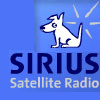
|
 |
DAILY BRIEFING Other stories making news today
|
 |
Space-age ID system takes parts tracking to new heights -- Think of them as barcodes with an attitude. They're permanent, scannable, sometimes invisible and they're popping up on items from vitamins to computer chips. They're matrix symbols, first studied for use by NASA in 1987 to help in tracking Space Shuttle components.
|
 |
|
Saturday:
August 12, 2000 | |
0845 GMT |
 |
Lightning threat scuttles shuttle shuffle
The threat of lightning at Kennedy Space Center early this morning has forced NASA officials to delay by one day the "rollaround" of space shuttle Atlantis for a fit check of the new hurricane Safe Haven.
 FULL STORY FULL STORY
 |  |

|
 |
Students find centaurs and unique asteroids
Thanks to the pioneering asteroid survey Spacewatch and similar projects, our planetary system appears as a humming hive populated with countless asteroids circling the sun like a swarm of bees.
 FULL STORY FULL STORY
 |  |
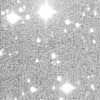
|
 |
DAILY BRIEFING Other stories making news today
|
 |
Newest Cluster 2 satellites give themselves a boost -- Following this week's successful launch of the second pair of four ESA Cluster satellites on August 9th, Rumba and Tango are heading towards their final operational orbits. Read the latest status on the craft.
|
 |
|
Friday:
August 11, 2000 | |
0437 GMT |
 |
Europa's surface has folds
Researchers may have solved a 20-year-old geological mystery surrounding Jupiter's icy moon Europa. A report today says evidence has been found of "folds" on the moon's frozen surface.
 FULL STORY FULL STORY
 |  |
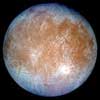
|
 |
Youngest pulsar found in heart of exploded star
A team of astronomers have discovered the youngest pulsar yet, a hot, spinning, highly-magnetized infant no larger than Manhattan, born in a massive star explosion about 700 years ago. It possesses unusual properties that may force
scientists to reconsider how pulsars are created and evolve.
 FULL STORY FULL STORY
 |  |
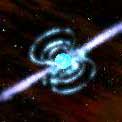
|
 |
DAILY BRIEFING Other stories making news today
|
 |
Ice worlds beyond Neptune yield clues to solar system -- Over the past decade, planetary astronomers have begun to seriously explore the Edgeworth-Kuiper Belt of comets and "ice dwarf" worlds near the edge of the solar system, providing new theories about the early solar system.

7000-lb telescope mirror ready for polishing -- The 7,000 pound, 10-cm thick piece of glass destined to become the SOAR Telescope's primary mirror has safely traveled from the Canton, NY plant of Corning, Inc. to Raytheon, Inc. in Danbury, CT. The glass will spend the next year being polished.
|
 |
|
Thursday:
August 10, 2000 | |
1700 GMT |
 |
NASA plans to send twin rovers to Mars in 2003
The traffic on Mars is expected to double in the near future. NASA today announced plans to launch two large scientific rovers to the red planet in 2003, rather than the original plan for just one.
 FULL STORY FULL STORY
 |  |
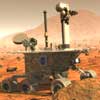
|
 |
Inflatable space structures will help study universe
Large telescopes and structures 10 times the size of the Rose Bowl that can be compacted and deployed in a single small launch vehicle and then inflated once they are in orbit are a major part of the future of Earth and space exploration.
 FULL STORY FULL STORY
 |  |

|
 |
Onboard camera views Cluster satellite in space
The tiny digital camera aboard the Cluster spacecraft Rumba made a piece of space history Wednesday by capturing the first color pictures ever taken from orbit as two unmanned satellites separated and drifted apart from each other.
 FULL STORY FULL STORY
 |  |

|
 |
DAILY BRIEFING Other stories making news today
|
 |
Looking for other Earths -- More than 40 planets outside our solar system have already been found but none of them resembles the Earth. Astronomers have not given up hope of uncovering alien worlds with rocky surfaces or breathable atmospheres.

Solar radiation rises to an 11-year high -- The Sun's brightness has been increasing steadily for the past 3 years. High precision instruments on board spacecraft have been monitoring the Sun since 1984 for the slightest changes, yielding a detailed picture of how the Sun's output varies over time.
|
 |
|
Wednesday:
August 9, 2000 | |
1247 GMT |
 |
Cluster 2 quartet complete
A Russian-made, French-marketed Soyuz rocket today lofted the second half of the European Space Agency's Cluster 2 space weather satellite quartet. Liftoff occurred on schedule from pad 6 at the Baikonur Cosmodrome in Kazakhstan and the spacecraft were deployed into a highly elliptical orbit around Earth some 90 minutes later.
 MISSION STATUS CENTER MISSION STATUS CENTER
 |  |

|
 |
Comet LINEAR's 'shower' observed from Earth
In a textbook example of useful collaboration between ground- and space-based astronomical telescopes, the ESO Very Large Telescope has imaged the "shower" of "mini-comets" in Comet LINEAR, first seen by the Hubble Space Telescope a few days ago.
 FULL STORY FULL STORY
 |  |

|
 |
Russian, American firms get OK for station module
A Joint Resolution Document between the Russian Aviation and Space Agency and RSC Energia confirms agreements to replace the Docking and Stowage Module of the international space station with the commercial module Enterprise.
 FULL STORY FULL STORY
 |  |

|
 |
Cargo freighter docks to international space station
An unmanned cargo ship launched Sunday from the Baikonur Cosmodrome in Kazakhstan successfully docked with the international space station Tuesday, carrying critical supplies and equipment to ready the lab for arrival of its first full-time crew in November.
 FULL STORY FULL STORY
 PROGRESS 251/1P DETAILED TIMELINE PROGRESS 251/1P DETAILED TIMELINE
 SPACE STATION INDEX SPACE STATION INDEX
 |  |

|
 |
DAILY BRIEFING Other stories making news today
|
 |
Asteroid exploration mission gets change of destination -- A joint Japanese-U.S. mission will be headed to a different asteroid for in-depth studies in the next few years. The change also means a different launch period for the spacecraft in question -- the Mu Space Engineering Spacecraft-C (MUSES-C).

Astronomers plan world's largest telescope -- Leading astronomers from Europe, North America, Asia and Australia have signed an agreement jointly to plan a huge new radiotelescope, the Square Kilometre Array (SKA), which will come into operation in the middle of the next decade.
|
 |
|
Tuesday:
August 8, 2000 | |
0257 GMT |
 |
New images are best views yet of Saturn's moon Titan
Some of the best images ever obtained by a ground-based telescope of Saturn's mysterious moon Titan confirm earlier observations showing that there is a brightly reflecting area in the equatorial zone, possibly an ice-covered mountainous plateau.
 FULL STORY FULL STORY
 |  |

|
 |
Finding alien planets by reading a swirl of dust
Some mystics claim to divine the future in the swirl of tea leaves at the
bottom of a cup, but astronomers may be able to perform an equally
impressive feat -- read the patterns imprinted in dust disks around nearby
stars to find hidden planets.
 FULL STORY FULL STORY
 |  |
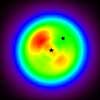
|
 |
DAILY BRIEFING Other stories making news today
|
 |
Republicans add pro-space plank to convention platform -- Republicans added language promoting space to their 2000 National Convention Platform last week, including a claim to boosting NASA's fortunes with stronger oversight. The move may set up a first for recent Presidential campaign history-dueling political parties supporting increases for space activities.

Earthlings guide Galileo probe on tour of Jupiter -- The cold dark vacuum of space envelops Galileo as it continues its journey around our solar system's largest planet, Jupiter. Galileo is not alone on this journey, however, as a dedicated crew of people here on Earth monitor its health and care for its every need.
|
 |
|
Monday:
August 7, 2000 | |
1735 GMT |
 |
Hubble discovers missing pieces of Comet LINEAR
To the surprise and delight of astronomers, NASA's Hubble Space Telescope has discovered a small armada of "mini-comets" left behind from what some astronomers had prematurely thought was a total disintegration of the explosive Comet LINEAR.
 FULL STORY FULL STORY
 |  |
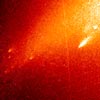
|
 |
New planet found in Earth's cosmic neighborhood
Astronomers have discovered a new planet in a solar system only 10.5 light-years away from Earth. The planet, which is composed of gas, is orbiting a star called Epsilon Eridani.
 FULL STORY FULL STORY
 |  |
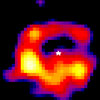
|
 |
Planet shower goes on with six other worlds found
Today at the International Astronomical Union General Assembly scientists will report the discovery of a second extra-solar planetary system with two Saturnian planets around one star plus other planet finds.
 FULL STORY FULL STORY
 |  |

|
 |
New discoveries hint to many multi-planet systems
As they add another three to the list of over 40 known planets outside our solar system, a team of astronomers based in California is beginning to see patterns, including hints that many extrasolar planets may have siblings.
 FULL STORY FULL STORY
 |  |

|
 |
Atlantis to depart hangar
Shuttle Atlantis should take a major step toward its mid-September launch today by rolling from a processing hangar to the Vehicle Assembly Building at Kennedy Space Center for attachment to an external fuel tank and solid rocket booster stack.
 MISSION STATUS CENTER MISSION STATUS CENTER
 |  |

|
 |
 |

